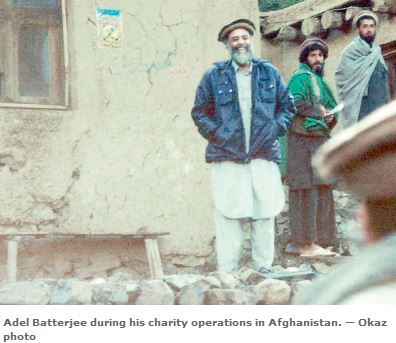
The relationship is simple. Jihadists know they can trust sharia-compliant banks to maintain their anonymity, not ask too many questions, and facilitate high-dollar transactions on behalf of their terrorist groups. Some Islamic financial institutions, such as National Commercial Bank and Islami Bank Bangladesh, have taken the relationship a step farther by donating a portion of their bank profits in the form of zakat as an act of corporate “charity” to terrorist organizations, or in the case of Al Rajhi, through private zakat donations of leading bankers. Saudi Arabia and Iran are key bases for these activities, but this is a global phenomenon. Here’s Money Jihad’s short list of the worst offenders:
Al Rajhi Bank: The Saudi financial institution has served as the sharia bank of choice for the world’s jihadists, including East Africa embassy bomber Mamduh Mahmud Salim, Al Qaeda leader Ayman al-Zawahiri, and organizations like Indonesian Kompak and Al-Haramain. Bank co-founder Sulaiman Al-Rajhi appeared on the infamous Golden Chain document of Al Qaeda financiers. These allegations were reinforced by the recent U.S. Senate investigation into HSBC’s correspondent relationships.
Al Shamal Islamic Bank: Osama Bin Laden co-founded the Al Shamal in Sudan and invested $50 million there. During the 1990s and early 2000s, Al Qaeda distributed money to its cells through Al Shamal. Funds passed through Al Shamal were used in preparation for terrorist attacks.
National Commercial Bank: Offering conventional and sharia banking services, Saudi Arabia’s self-described first, largest, and most prominent bank is NCB. Among other misdeeds, a Saudi audit revealed that NCB transferred $74 million in the 1990s as zakat through its charitable front organizations to Al Qaeda (see here, here, and here). Khalid bin Mahfouz, the head of the bank, exploited libel laws to sue author Rachel Ehrenfeld in an effort to silence accusations about his role in financing terrorism.
Arab Bank: This conventional bank in Jordan maintains a wholly-owned subsidiary (Islamic International Arab Bank PLC) that offers full-range sharia services. Arab Bank has transferred money on behalf of Comité de Bienfaisance et de Secours aux Palestiniens (CBSP), a notorious French charity, to a known financial subunit of Hamas. The Jordanian bank has paid out insurance benefits to families of suicide bombers for the Saudi Committee—another charity that funds Hamas. Arab Bank has handled transactions for the Holy Land Foundation, whose leaders now sit behind bars for financing terrorism. It has been the subject of American investigations, but the bank has consistently refused to turn over related documents to the U.S.
Islami Bank Bangladesh Limited: IBBL, Bangladesh’s biggest sharia bank, has handled Wahhabi accounts to propagate radical Islam since its inception. In 2011, the Bangladeshi home ministry intelligence revealed that 8 percent of the bank’s profits were diverted as corporate zakat to support jihad in Bangladesh. One of the men on IBBL’s board of sharia advisors was arrested in connection with a terrorist attack against Bangladeshi police officers. The U.S. Senate slammed British bank giant HSBC for maintaining relationships with IBBL despite evidence that it served terrorists like Shaikh Abdur Rahman of Jamatul Mujahideen Bangladesh and terror-funding Islamic charities like IIRO. The Senate’s report also implicated HSBC for disregarding evidence of terror financing at another Bangladeshi sharia bank with whom it worked: Social Islami Bank.
Bank Melli: The Iranian Islamic bank sent “at least $100 million to an Iranian Revolutionary Guard branch that supports Hamas, Palestinian Islamic Jihad, and other terrorist groups, the Quds Force” between 2002-06.
Bank Saderat: Another major Iranian sharia finance house, the U.S. Treasury Department sanctioned the rocket-funding Bank Saderat, stating that “The bank is used by the Government of Iran to transfer money to terrorist organizations, including Hizballah, Hamas, the Popular Front for the Liberation of Palestine-General Command and Palestinian Islamic Jihad. A notable example of this is a Hizballah-controlled organization that has received $50 million directly from Iran through Bank Saderat since 2001.”
Other culprits include Dubai Islamic Bank, which is active in both the U.A.E. and Pakistan, and Tadamon Islamic Bank.
So much for “ethical finance.” For further developments, please continue reading Money Jihad, Shariah Finance Watch, and @moneyjihad on Twitter.




Osama’s last bequest: $29m for jihad
March 15, 2016Authorities have released Osama bin Laden’s last will and testament. It was taken from his hideout in Pakistan. It is interesting that he intended to leave most of his money to family members with the assumption that they would carry out his work. We had been told elsewhere by defenders of Saudi Arabia that the Bin Laden family construction company and the Bin Laden relatives have nothing to do with Osama. Perhaps not. Remember that Osama’s sister-in-law, Carmen bin Laden, once said, “Bin Ladens never disowned Osama; in this family, a brother remains a brother, no matter what he has done.”
The other interesting point is that this serves as further evidence that Osama bin Laden did not exhaust his personal wealth for Al Qaeda operations. He used other people’s money for that. Neither the Sept. 11, 2001 attacks nor the Afghan mujahideen’s fight against the Soviets were funded from bin Laden’s private accounts, contrary to the public image he liked to present.
Posted in News commentary | Tagged bin Laden group, Osama bin Laden, Sudan | Leave a Comment »